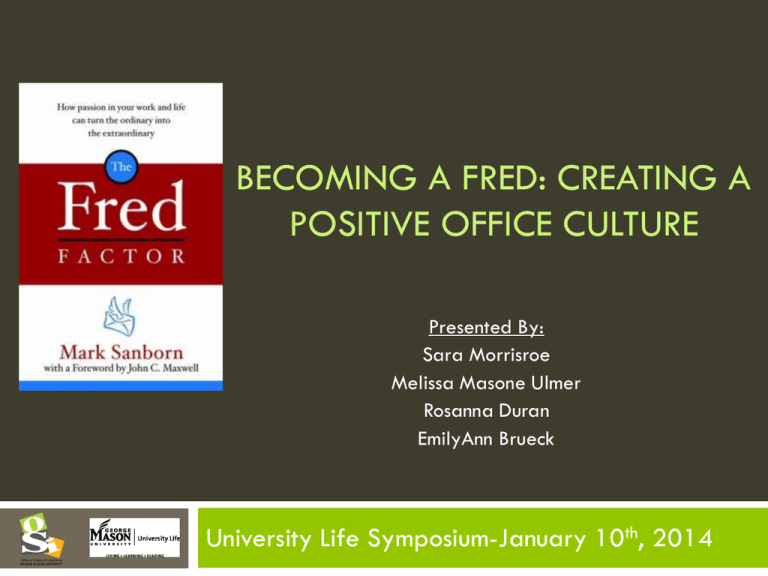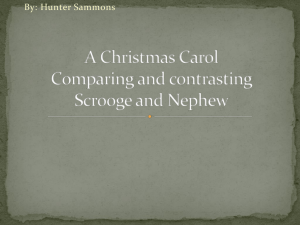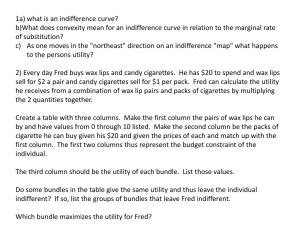Becoming a Fred - University Life Professional Symposium
advertisement

BECOMING A FRED: CREATING A POSITIVE OFFICE CULTURE Presented By: Sara Morrisroe Melissa Masone Ulmer Rosanna Duran EmilyAnn Brueck University Life Symposium-January 10th, 2014 Presentation Outline Introductions & Welcome Part 1: What’s a Fred Part 2: Research Findings on Wellness/Positivity in the Workplace Part 3: Applicability- Becoming a Fred & Developing Others Part 4: Show Appreciation Q&A TWEET US THROUGHOUT THE PRESENTATION Have an example of a FRED? Experienced something worth sharing during the day? Tweet using #ULFRED & #ULSYMPOSIUM throughout the day, so we can start our own Mason FRED FACTOR movement. Learning Outcomes As a result of attending this session attendees will… Gain an understanding of what “The Fred Factor” is and what it means to be a Fred. Receive data and information on how a focus on well-being and positivity has implications in the workplace. Be able to apply the knowledge gathered from research to real life. Learn how to create a positive office culture. Develop strategies to help our students be better prepared contributors to society and more appealing to employers What’s a Fred? The First Fred… The Fred Factor Movement “He believed that excellence and quality should be the goals of every person in any business or profession.” (p.6) “Anyone can be a FRED! That includes you! The result will not just be extraordinary effort and success in your work. You’ll find yourself living an extraordinary life as well.” (p.7) What’s a Fred? The Fred Principles… 1. Everyone Makes a Difference “…only the employee can choose to do his or her job in an extraordinary way, regardless of the circumstances.” (p.9) #CHOOSEYOURATTITUDE “NOBODY CAN PREVENT YOU FROM CHOOSING TO BE EXCEPTIONAL.” (p.9) “…there are no insignificant or ordinary jobs when they’re performed by significant and extraordinary people.” (p.10) 2. Success is Built on Relationships “…because the quality of the relationship determines the quality of the product or service.” (p.11) Leaders succeed when they recognize that their employees are human; Technology succeeds when it recognizes that its users are human; and Employees like Fred the Postman succeed when they recognize their work involves interacting with human beings. What’s a Fred? The Fred Principles… 3. You Must Continually Create Value for Others, And it Doesn’t Have to Cost a Penny “Being employable means having a skill set that makes you desirable to any employer, regardless of industry or geographic location.” (p.13) “…the ability to create value for customers and colleagues without spending money to do it.” (p.13) 4. You Can Reinvent Yourself Regularly “I believe that no matter what job you hold, what industry you work in, or where you live, every morning you wake up with a clean slate. You can make your business, as well as your life, anything you choose it to be.” (p.15) What’s a Fred? Fred Sightings! Fred Sightings! Have you served as a Fred OR witnessed someone else display Fred behavior? Tell us about it! How to Stay Motivated as Freds: 1. 2. 3. 4. 5. 6. Do good & you’ll feel good. The best never rest. Treat customers (“students”) and others as friends. The impact you have on others is the reward. Live the Golden Rule. Fear nothing except to waste the moment. Positivity Leads to Success Mental Benefits Social Benefits High quality relationshipspersonal growth, creativity & motivation Psychological Benefits Positive emotions associated with greater creativity, mind clarity Relationships are the most potent predictor of psychological health (Reis, 2012) Health Benefits Positive people are physically healthier Six Essentials of Workplace Positivity Positive Thinking Positive Relationships Strengths Empowerment Meaning Well-Being For Supervisors Lead with warmth first followed by knowledge People who love their jobs also have bosses who inspire them, get the most out of them, and truly care about them Provide opportunities for employees to experience “flow” in their jobs What Can YOU Do to Make a Difference? Job Crafting Practice Mindfulness Cultivate Your Strengths Discover Your Purpose Celebrate Progress Nurture Relationships Applicability-Becoming a Fred & Developing Others FRED: Find Reward Educate Demonstrate “Uninspired people rarely do inspired work.”-Mark Sanborn Find Let Them Find You Discover Dormant Freds Hire Freds Build Your Fred Team Reward When the Fred Factor is fully operative: Even the smallest gestures make the world a better place. Intentions Count Too Reward a Fred for good intentions as for stellar outcomes No one likes to fail, but it is important for an employee to know that taking chances to do the right thing will be acknowledged Implement Your Reward Strategy Make sure your team knows they’re making important contributions Tell them the difference they are making and be specific, give examples Create an award (i.e. Fred of the Week) Get the leader of the your organization to send a note or make a phone call to your employee Recognize, reinforce, and repeat! “We don’t get the behavior we hope for, beg for or demand. We get the behavior we reward.” - Dr. Michael LeBoeuf Author of the book, “The Greatest Management Principle in the World” Educate Find Examples Everywhere Dissect and Debrief A positive change will not endure unless we understand why it worked. Teach Miracle Working As you become increasingly interested in developing the art of the extraordinary in yourself and others, you’ll notice more and more examples. Don’t wait for a crisis! Perform miracle working on a regular basis. Pull, Don’t Push Use your enthusiasm and commitment to gain their participation and involvement. “The size of the miracle is less important than it’s frequency.” (p.89) Demonstrate Do you have a friend that inspires you by his or her example? The Magic Question: What could you do to set an example and inspire your employees to serve our students, vendors, and fellow employees better? Inspire, don’t intimidate Involve It’s far more effective than suggesting or asking. Initiate Share a Fred story. Don’t wait for the “right moment”, it might never come. Improvise The situation doesn’t determine the outcome; the participants do. Go Spread Fred Recognize the Freds in your life Acknowledge Freds for their contribution Pay Fred’s back Summary The Science of Happiness - An Experiment in Gratitude (SoulPancake.com) The Fred Movement isn’t just about going above & beyond, but it’s also about recognizing the Freds in your life and THANKING them. “People become more lovable when they are loved.” (p.107) University Life, Show You Care Activity: Write a note to someone who has demonstrated themselves as a Fred to you. Here’s your opportunity to recognize their effort & make their day! We’ll deliver it for you! References Cabrera, E. (2012). The six essentials of workplace positivity. People & Strategy 35(1), 50-60. Canevello, A., & Crocker, J. (2011). Interpersonal goals and close relationship processes: Potential Links to health. Social and Personality Psychology Compass, 346-358. Csikszentmihalyi, M. (1990). Flow: The psychology of optimal experience. New York, NY: Harper & Row. Cuddy, A., Kohut, M., & Neffinger, J. (2013). Connect, then lead. Harvard Business Review (91)7, 57-61. Drigotas, S. M., Whitton, S. W., Rusbult, C. E., & Wieselquist, J. (1999). Close partner as sculptor of the ideal self: Behavioral affirmation and the Michelangelo phenomenon. Journal of Personality and Social Psychology, 77(2), 293-323. Harter, J., & Rath, T. (2010). Well-being: The five essential elements. New York, NY: Gallup Press. Huppert, F. A. (2009). Psychological well-being: Evidence regarding its causes and consequences. Applied Psychology: Health and Well-Being, 1(2), 137-164. Kim, E., & Yoon, D.J. (2012). Why does service with a smile make employees happy? A social interaction model. Journal of Applied Psychology (97)5, 1059-1067. Hartung, P.J., & Taber, B.J. (2007). Career construction and subjective well-being. Journal of Career Assessment (16)1, 75-85. Kidd, J.M. (2008). Exploring the components of career well-being and the emotions associated with significant career experiences. Journal of Career Development (35)2, 166-186. Lopez, S. (2013). Making hope happen: Create the future you want for yourself and others. New York, NY: Atria Books. Phillips, E. (2013). Go with the flow: engagement and concentration are key. Harvard Medical School. Retrieved from http://www.health.harvard.edu/blog/go-with-the-flowengagement-and-concentration-are-key-201307266516 Reis, H. T. (2012). Perceived partner responsiveness as an organizing theme for the study of relationships and well-being. In L. Campbell, & T. J. Loving, (Eds.), Interdisciplinary research on close relationships: The case for integration (pp. 27-52). Washington, DC: American Psychological Association. Sanborn, M. (2004). The Fred Factor. Great Britain, UK: Random House Business Books. Don’t forget to tweet us throughout the day & keep using #ULFRED to capture your FRED moments! THANK YOU FOR COMING! “What makes any act extraordinary is doing it with heart. What makes any life extraordinary is living it with love. That’s the secret of the Fred Factor.” (p.108) -Mark Sanborn








